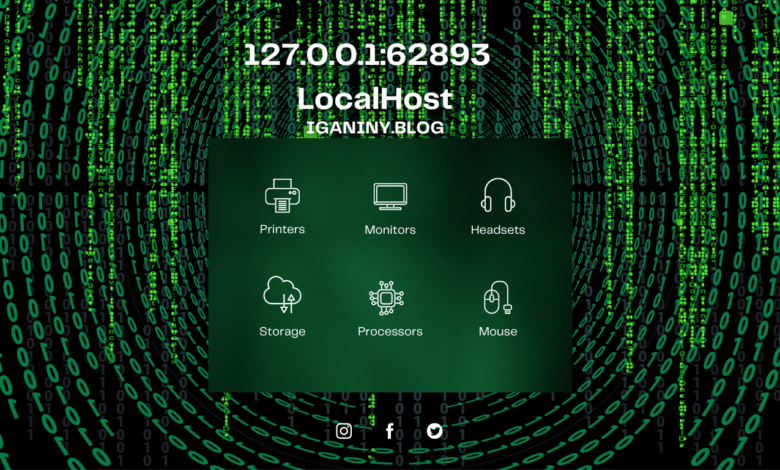The Untold Story of 127.0.0.1:62893

Cracking the Code of 127.0.0.1
Are you a tech enthusiast eager to unravel the mysteries of 127.0.0.1:62893? You’re in the right place. This blog post will decode the meaning behind 127.0.0.1, especially when coupled with the port 62893. Whether you’re a developer or just curious about IP addresses, read on to discover why 127.0.0.1 is more significant than you might think.
What is 127.0.0.1?
The Loopback IP Unveiled
The IP address 127.0.0.1 is often called the “loopback” or “localhost” address. But what does it really mean? In simple terms, it’s like writing a letter to yourself. When you type 127.0.0.1 into your browser, you’re telling your computer to communicate with itself. This internal communication is crucial for testing and development tasks.
Why 127.0.0.1 Matters
Why not use any other number? The 127.0.0.1 address is reserved specifically for loopback. It’s a standard across all devices and operating systems, making it a universal way to test network applications without needing an actual network.
How Does it Work?
When a device sends data to 127.0.0.1, it doesn’t leave the device. Instead, it loops back to the sender. This functionality is essential for developers who need to test network software without the risk of exposing their system to external threats.
—
The Role of Port 62893
Understanding Ports
What’s a port, anyway? Think of it as a doorway in a house. While the IP address is the house’s address, the port is a specific door where data can enter or exit. Ports number from 0 to 65535, each designated for different types of traffic.
Why Use Port 62893?
Port 62893 isn’t special in itself but serves as an example of a high-numbered port often used in development. High-numbered ports are usually less regulated, offering more freedom for testing and custom applications.
Combining 127.0.0.1 and 62893
When you see 127.0.0.1:62893, it’s a way to direct traffic to port 62893 on your local machine. This combination lets you run multiple applications locally without conflicts, each using different ports.
—
Developer’s Playground
Local Testing Made Easy
Developers often use 127.0.0.1 with various ports for local testing. This setup allows them to debug and fix issues before deploying to a live environment. It’s a safe sandbox where mistakes won’t affect real users.
Simulating Real-World Scenarios
Using 127.0.0.1, developers can simulate real-world scenarios. For instance, they can test how an application behaves under heavy load or check how it interacts with other software components.
Saving Time and Resources
Local testing on 127.0.0.1 saves time and resources. There’s no need to set up complex external networks or worry about internet connectivity. Everything happens on the developer’s machine, making the process more efficient.
—
Real-World Applications
Network Configuration
In network configuration, 127.0.0.1 helps verify if TCP/IP is functioning correctly. By pinging 127.0.0.1, administrators can confirm that the network stack is operational without needing an external network connection.
Troubleshooting Made Simple
Troubleshooting network issues can be daunting. However, 127.0.0.1:62893 simplifies the process. If a service works on 127.0.0.1 but not on an external IP, it indicates a network configuration problem rather than a software issue.
Local Server Setup
Setting up a local server for development purposes is another common use. By running servers on 127.0.0.1 with different ports, developers can test web applications, databases, and more without risking exposure to the internet.
—
SEO Benefits of Knowing 127.0.0.1
Enhancing SEO Strategies
Believe it or not, understanding 127.0.0.1 can enhance your SEO strategies. By using local servers for testing, you can ensure that your website is fully optimized before going live. This preemptive approach can improve load times and user experience, both critical factors for SEO.
Driving Traffic
Once your site is live, the insights gained from local testing can help drive valuable traffic. A well-optimized site ranks higher on search engines, attracting more visitors and potential customers.
Avoiding Common Pitfalls
Many top websites aren’t accessible due to overlooked issues during development. Using 127.0.0.1 for testing ensures these problems are caught early, preventing poor SEO performance and user dissatisfaction.
—
The Future of 127.0.0.1
Evolution of Local Testing
The concept of 127.0.0.1 is evolving. With advancements in automation and AI, local testing environments are becoming more sophisticated. Future tools may offer even more robust ways to simulate and test applications locally.
Relevance in Modern Development
Despite new technologies, 127.0.0.1 remains relevant. Its simplicity and effectiveness make it a staple in modern development practices. Whether it’s for debugging, testing, or network configuration, 127.0.0.1 is here to stay.
Preparing for Tomorrow
Staying ahead in the digital landscape means understanding foundational concepts like 127.0.0.1. By mastering these basics, you’ll be better prepared for future technological advancements and challenges.
—
Wrapping Up
In essence, 127.0.0.1, especially when paired with port 62893, is more than just a technical detail. It’s a powerful tool for developers and businesses alike. From simplifying local testing to enhancing SEO strategies, the applications are vast and impactful.
Ready to elevate your development game? Start exploring the potential of 127.0.0.1 today. The more you understand, the more you can innovate. And if you need further guidance, our team is here to help you master these fundamental concepts. Happy developing!



